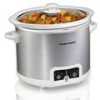Hamilton Beach 33252 Use & Care - Page 6
Tips for Slow Cooking
 |
UPC - 040094332526
View all Hamilton Beach 33252 manuals
Add to My Manuals
Save this manual to your list of manuals |
Page 6 highlights
840178203 ENv01.qxd:Layout 1 8/25/10 2:57 PM Page 6 Tips for Slow Cooking • Foods will continue to increase in temperature after desired temperature has been reached. • The removable stoneware crock should be at least half-filled for best results. If only half-filled, check for doneness 1 to 2 hours earlier than recipe. • Stirring is not necessary when slow cooking and removing the glass lid results in major heat loss and the cooking time may need to be extended. However, if cooking on High, you may want to stir occasionally. • If cooking soups or stews, leave a 2-inch space between the top of the removable stoneware crock and the food so that the recipe can come to a simmer. • Many recipes call for cooking all day. If your morning schedule doesn't allow time to prepare a recipe, do it the night before. Place all ingredients in the removable stoneware crock, cover and refrigerate overnight. In the morning, simply place the removable stoneware crock in the slow cooker. • Do not plug steam vent holes with paper towels or other objects. Steam vent holes allow steam to escape and wattage has been adjusted to compensate for heat loss. • Do not use frozen, uncooked meat in the slow cooker. Thaw any meat or poultry before slow cooking. 6 • Some foods are not suited for extended cooking in the slow cooker. Pasta, seafood, milk, cream, or sour cream should be added 2 hours before serving. Evaporated milk or condensed soups are perfect for the slow cooker. • The higher the fat content of the meat, the less liquid is needed. If cooking meat with a high fat content, place thick onion slices underneath so the meat will not sit on (and cook in) the fat. • Slow cookers allow for very little evaporation. If making your favorite soup, stew, or sauce, reduce the liquid called for in the original recipe. If too thick, liquid can be added later. • If cooking a vegetable-type casserole, there will need to be liquid in the recipe to prevent scorching on the sides of the removable stoneware crock. • To keep previously cooked food warm (food that is already at the desired temperature), select the Warm setting. • Reduce temperature of leftover food as quickly as possible by dividing the meal into smaller portions and placing into shallow, airtight containers to be refrigerated. Visit www.hamiltonbeach.com for our complete line of products and Use and Care Guides - as well as delicious recipes, tips, and to register your product online!















